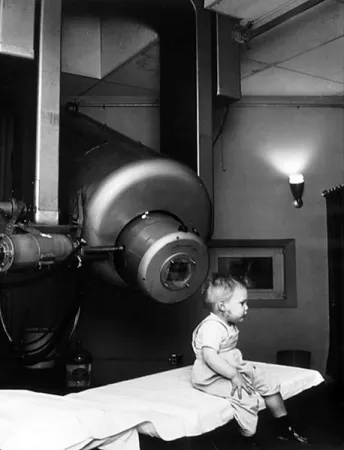Revolutionizing radiation treatment
This article was originally written and submitted as part of a Canada 150 Project, the Innovation Storybook, to crowdsource stories of Canadian innovation with partners across Canada. The content has since been migrated to Ingenium’s Channel, a digital hub featuring curated content related to science, technology and innovation.
Victoria Dalgleish
Algonquin College Journalism Program
When her mother developed breast cancer, Mildred Vera Peters gained a new perspective. The only treatment for breast cancer at this time was to have a mastectomy. But the cancer returned, and Peters’ mother had to undergo radiation. She was inspired by the concept of treating the whole body instead of only the area affected.
Born in, 1911 at a dairy farm outside of Toronto, Peters excelled at school and attended the University of Toronto. Peters took her medical apprenticeship at the Toronto General Hospital. There she studied Hodgkin’s disease. In 1950 Peters published a paper demonstrating that patients with Hodgkin’s could be completely cured if given high radiation. The notion that Hodgkin’s could be cured was quite ground-breaking, and her findings were criticized.
In 1958 Peters began to study the use of radiation therapy in treating breast cancer. She spent nine years studying 7,000 records of patients and found no difference in the five year survival rates of patients treated with a lumpectomy and radiation, in comparison to those who underwent a mastectomy. It took years for her research to gain acceptance, but eventually her findings led to the less invasive breast cancer treatments.
Peters died in 1993. In recognition of her innovative work, she was inducted into the Canadian Medical Hall of Fame in 2010 and the Canadian Science and Engineering Hall of Fame in 2013.
Transcript
Born on a dairy farm near Toronto, Dr. Mildred Vera Peters is most notably recognized as an outstanding clinical investigator who changed the management of Hodgkin's disease and breast cancer. In addition, her legacy as a clinician her deep desire to know and involve her patients in decision-making also marks her as a truly unique and compassionate innovator who was ahead of her time.
One cannot fully appreciate the impact of Dr. Peters work without taking into account the challenges she faced as a female in an era when women were not universally accepted as scientists. To graduate in the 1930s from medical school and emerge out of the 1960s as a world-class figure in oncology is a testament to her dogged determination and ingenuity.
Claiming that research isn't a question of time but a matter of curiosity, Dr. Peters was a great observer who was driven by the need to explain all that she observed. In 1935, she joined the father of the discipline of radiation therapy in Canada, Dr. Gordon Richards, at Toronto General Hospital who suggested that she study Hodgkin's disease. This led to her landmark publication in 1950 that showed that a high proportion of patients with early-stage Hodgkin's disease considered incurable at the time could be cured if treated with high dose radiation.
From 1958 to her retirement in 1976, Dr. Peters worked at the Princess Margaret Hospital where her relentless pursuit of scientific truth with respect to treating early-stage cancer of the breast proved that breast-conserving surgery (lumpectomy) followed by radiation is as effective as radical mastectomy. Her findings in both Hodgkin's disease and breast cancer, although initially met with skepticism, became common practice throughout Canada and the world.
Successfully married with two children, Dr. Peters had an extraordinary ability to balance and separate her professional and personal worlds to the point that she was known as Mrs. Lobb at home and Dr. Peters at the hospital. Women then, today and for generations to come will continue to be inspired by this remarkable role model.
Dr. Peters was appointed a Member of the Order of Canada in 1975 and an Officer of the Order of Canada in 1977. She was the recipient of the Gold Medal from the American Society for Therapeutic Radiology and Oncology in 1979. Among numerous honours, Dr. Peters has been awarded two honourary doctorates (York University, 1975; Queens University, 1983).


















